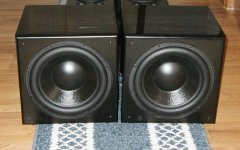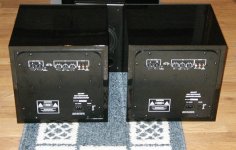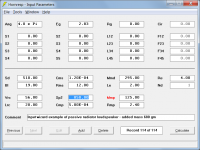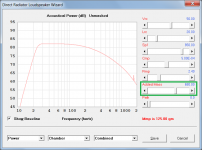"But that's TWO drivers in a very big cabinet."
And mounted push-pull for distortion reduction.
And mounted push-pull for distortion reduction.
Two Dayton Audio RSS265HF-8 in a 60 liter sealed enclosure will give you an extra 6dB at 20Hz, 7dB at 30Hz, 8dB at 40Hz per watt at less than half the price of the 8W7. Add +6dB of extra headroom as a bonus ! High usable frequency range .
Last edited:
It's not designed for SPL competition. I think you're confusing with other brands such as RE, Sundown, CV, Orion and so on...
Despite never having personally heard one, I know about the driver. It's a fine quality driver. What I said was that if it were INCORPORATED into an spl comp system it would sound terrible, that's due to the setup, not the driver. And the reason I mentioned that is because you are measuring max spl in room at frequencies that align with room modes.
Anyway, so far the 49 liters sealed + 8W7 SMOKED the other enclosures/drivers i tested in the 30hz region... There is no comparision to be made, there is no serious contender! That will change very soon.
The thing is: that 8W7 is pretty much THE best solution among all 8'' nominal size driver. 216mm outer diameter is quite small and that is useful in my case. I'm sure not aware of any other driver this size that is capable of almost 500cm³ Vd... That seems underrated btw.
Well yeah, the driver you chose doesn't have much competition in it's size class. There are a few that will beat it but those are the car audio type drivers with super high Le. I didn't realize you were shooting for a cab under 50 liters though, so your choice will be hard to beat.
Just remember, the frequency response is complex, you can't just measure at a couple of frequencies and be done. EVERYTHING will affect the frequency response. Get a high xmax 8 inch driver with very high qts and very high Le and you will have a nice boost in the 30 - 40 hz range, a lot more than your driver.
If you refer to post #1, it says that i'm looking for a ''Limited enclosure volume (relatively)'' and by relatively, it meant i didnt know what would be the threshold of diminishing return. Now, i think we can narrow it down to 40-70 liters total cabinet size. Which makes the Tapped horn solution almost impossible, unless you're using a 6'' driver. So what's left is the BR and PR.
If you have room for BR you have room for a reverse taper tl.
I mean: 115db is a nice-to-have compared to 105db, at those low frequencies, but 125db V.S. 115db ? Not so sure. Not so sure i'd use that potential that often... But 115db ? Yes.
The extra headroom is good even if you never use it. It just means lower distortion at any given spl.
FYI, the THSpud from Danley is a great reference point here:
https://www.danleysoundlabs.com/danley/wp-content/uploads/2012/04/TH-Spud-spec-sheet11.pdf
That's roughly 130 liters PER 8'' (they use 8 inches high excursion as well)
and we're talking 126db max SPL somewhere in the 19hz-125hz, more like 120-122db in the 28-35hz, which is great. But that's TWO drivers in a very big cabinet.
The SPUD is tuned almost an octave below your stated 30 hz interests and THAT'S why it is huge. If it had been tuned to 30 hz it would be a LOT smaller and a LOT louder than your sealed box. There's just no comparison.
It would be interesting to compare to this, with a retune around 28-32 Hz, needs
a robust PR:
Digger8 Sub - diggity dig it all the way to 20Hz - Techtalk Speaker Building, Audio, Video Discussion Forum
"Small size overall of 1cf gross (about 0.85cf net) with a 9" x 14" footprint and 20" high"
"Modeled response shows the following. No EQ to boost or cut anything, just a 2nd order LR2 filter (which is what the plate amp uses) set at 100Hz for the model. Frequency Response pics in Post #23.
F3 = 20.17 Hz
F6 = 18.56 Hz
F10 = 17.08 Hz"
The driver is a better value IMO but I believe is also NLA.
Based on Fs and Vas I think that this woofer would work as a substitute, no idea of how rugged it is:
Tang Band W8-740P 8" Subwoofer
I'd probably tune to 25-28 for music and 20 ish for HT.
a robust PR:
Digger8 Sub - diggity dig it all the way to 20Hz - Techtalk Speaker Building, Audio, Video Discussion Forum
"Small size overall of 1cf gross (about 0.85cf net) with a 9" x 14" footprint and 20" high"
"Modeled response shows the following. No EQ to boost or cut anything, just a 2nd order LR2 filter (which is what the plate amp uses) set at 100Hz for the model. Frequency Response pics in Post #23.
F3 = 20.17 Hz
F6 = 18.56 Hz
F10 = 17.08 Hz"
The driver is a better value IMO but I believe is also NLA.
Based on Fs and Vas I think that this woofer would work as a substitute, no idea of how rugged it is:
Tang Band W8-740P 8" Subwoofer
I'd probably tune to 25-28 for music and 20 ish for HT.
Last edited:
I also built these sealed subs in the 1 cu ft (internal) prefab PE boxes, with the CSS Trio 12" and 500W Dayton plate amp.
Trio 12" is 491 cm sq SD and 2 cm Xmax for VD = 982 cu cm.
I'm going to guess that 2 cm Xmax is at 70% BL but not sure.
Trio 12 is NLA but I explore other possibilities in this thread:
12" Subwoofer for 1 cu ft 500W Sealed - Techtalk Speaker Building, Audio, Video Discussion Forum
Trio 12" is 491 cm sq SD and 2 cm Xmax for VD = 982 cu cm.
I'm going to guess that 2 cm Xmax is at 70% BL but not sure.
Trio 12 is NLA but I explore other possibilities in this thread:
12" Subwoofer for 1 cu ft 500W Sealed - Techtalk Speaker Building, Audio, Video Discussion Forum
Last edited:
This should be a good example of your example A.
My Trio12 sub from about 2010 in PE 1 cu ft internal boxes, don't know why they won't inline here:
NLA Trio 12" data sheet in .pdf: http://www.juoiga.eu/images/datasheets/css_trio12.pdf
When I demoed them, quite loud with War of the Worlds and other HT tracks it was easy
to light the yellow clip light on the 500W amps.
The floor felt like it was moving 1/4" and the picture window even more.
Unfortunately, we also smelled epoxy or enamel toward the end and the driver is supposed
to have a metal VC former.
Back in the 1990s on the Bass List I said that we need woofers with 10 - 20mm or more Xmax, we
have that now. Now I'll say that we need woofers with >6" voice coils or some sort of better thermal
management. We've gone in the opposite direction here to non-thermally conductive formers most
often seen in use - probably to get compression rather than mechanical destruction of drivers in
common vented use. But this is not the best optimization in my opinion - certainly not for sealed
systems.
A pair of these TB W8-740P 8" might work in place of the Trio 12" since a pair of 2" VCs act like a 4" (closer to 6")
and they claim that aluminum formers are used but the Qms does not support the claim. I also wonder
what the Xmech figure is, anyone seen Klippel data on these:
Tang Band W8-740P 8" Subwoofer
My Trio12 sub from about 2010 in PE 1 cu ft internal boxes, don't know why they won't inline here:
NLA Trio 12" data sheet in .pdf: http://www.juoiga.eu/images/datasheets/css_trio12.pdf
When I demoed them, quite loud with War of the Worlds and other HT tracks it was easy
to light the yellow clip light on the 500W amps.
The floor felt like it was moving 1/4" and the picture window even more.
Unfortunately, we also smelled epoxy or enamel toward the end and the driver is supposed
to have a metal VC former.
Back in the 1990s on the Bass List I said that we need woofers with 10 - 20mm or more Xmax, we
have that now. Now I'll say that we need woofers with >6" voice coils or some sort of better thermal
management. We've gone in the opposite direction here to non-thermally conductive formers most
often seen in use - probably to get compression rather than mechanical destruction of drivers in
common vented use. But this is not the best optimization in my opinion - certainly not for sealed
systems.
A pair of these TB W8-740P 8" might work in place of the Trio 12" since a pair of 2" VCs act like a 4" (closer to 6")
and they claim that aluminum formers are used but the Qms does not support the claim. I also wonder
what the Xmech figure is, anyone seen Klippel data on these:
Tang Band W8-740P 8" Subwoofer
Attachments
Last edited:
A pair of these TB W8-740P 8" might work in place of the Trio 12" since a pair of 2" VCs act like a 4" (closer to 6") and they claim that aluminum formers are used but the Qms does not support the claim.
From the Wikipedia page on the subject: "Aluminium was widely used in the speaker industry due to its low cost, ease of bonding, and structural strength. When higher power amplifiers emerged, especially in professional sound, the limitations of aluminium were exposed. It rather efficiently but inconveniently transfers heat from the voice coil into the adhesive bonds of the loudspeaker, thermally degrading or even burning them. Motion of the aluminium bobbin in the magnetic gap creates eddy currents within the material, which further increase the temperature, hindering long-term survival."
Yes, I've read that also but there are high temp epoxies that will take 400 deg F
or more but my view is not to allow them to get that hot in the first place.
The cone should probably be aluminum also which I think was the case with
the Epic 12 and most of the RS woofers. They could even extend the former as
I and Hartley did in the 1970s or use an actual heat sink as Kloss did in one of his
later designs.
If a VC is getting so hot that high temp adhesives are failing they are under abuse
conditions and my goal is to have far lower temps under all conditions.
Something else to keep in mind is that "in the old days" the AR-3 and Advent
woofers had .3 - .5 % efficiency with around 2" metal formers. Many modern
woofers have .1% efficiency so for the same thermal SPL limit they need 3 times
the thermal capacity.
or more but my view is not to allow them to get that hot in the first place.
The cone should probably be aluminum also which I think was the case with
the Epic 12 and most of the RS woofers. They could even extend the former as
I and Hartley did in the 1970s or use an actual heat sink as Kloss did in one of his
later designs.
If a VC is getting so hot that high temp adhesives are failing they are under abuse
conditions and my goal is to have far lower temps under all conditions.
Something else to keep in mind is that "in the old days" the AR-3 and Advent
woofers had .3 - .5 % efficiency with around 2" metal formers. Many modern
woofers have .1% efficiency so for the same thermal SPL limit they need 3 times
the thermal capacity.
Hi PB2,Something else to keep in mind is that "in the old days" the AR-3 and Advent woofers had .3 - .5 % efficiency with around 2" metal formers. Many modern woofers have .1% efficiency so for the same thermal SPL limit they need 3 times the thermal capacity.
If you calculate efficiency from idealized linear small signal parameters without considering losses or the fact that 'real' efficiency is frequency and enclosure depending, you are right ;-)
Regards,
Djim
Finally did a test using a passive radiator (Dayton RSS315-PR)
Dayton Audio RSS315-PR 12" Aluminum Cone Passive Radiator - Passive Radiators - Loudspeaker Drivers By Type - Loudspeaker Components
with the very same 49 liters enclosure and driver (8W7).
Looks promising for what i heard so far. Will probably need some adjustements to find the good weight to use, and maybe even 2x or 3x smaller passive rads instead, but the overall output is better below 30hz, with very decent results 'til 23hz (was probably tuned a bit too low).
Basically, in-room SPL from 23hz to 40hz in the 115-125db range. Very loud for a single 8'', that's for sure.
we'll continue the test with different tuning and passive rads... 🙂
Dayton Audio RSS315-PR 12" Aluminum Cone Passive Radiator - Passive Radiators - Loudspeaker Drivers By Type - Loudspeaker Components
with the very same 49 liters enclosure and driver (8W7).
Looks promising for what i heard so far. Will probably need some adjustements to find the good weight to use, and maybe even 2x or 3x smaller passive rads instead, but the overall output is better below 30hz, with very decent results 'til 23hz (was probably tuned a bit too low).
Basically, in-room SPL from 23hz to 40hz in the 115-125db range. Very loud for a single 8'', that's for sure.
we'll continue the test with different tuning and passive rads... 🙂
anybody knows how to simulate passive radiator with hornresp ?
By exemple, if i put 2 disks weight, i have a Fpr of 16.1hz and a Qmpr of 5.87 but where do i put these numbers ?
An externally hosted image should be here but it was not working when we last tested it.
By exemple, if i put 2 disks weight, i have a Fpr of 16.1hz and a Qmpr of 5.87 but where do i put these numbers ?
anybody knows how to simulate passive radiator with hornresp ?
By exemple, if i put 2 disks weight, i have a Fpr of 16.1hz and a Qmpr of 5.87 but where do i put these numbers ?
Use Unibox.
According to this website:
HUMAN Speakers: What is a passive radiator?
If i'm seeking for the highest output at 28hz, then i would simply need a Fpr of 28hz, which is not available anywhere (max would be around 21-23hz, for very limited Vd models). You can add weight but you can't remove it...
30.2hz
http://www.daytonaudio.com/media/resources/295-498-dayton-audio-sd175-pr-spec-sheet.pdf
...but 103cm³, pretty much useless in my case. Would need over a dozen.
HUMAN Speakers: What is a passive radiator?
a PR will respond to tones on each side of its resonance with a carefully controlled roll off. These are typically 18 dB/octave slopes, which while pretty steep, give the device a useful range of about half an octave.
If i'm seeking for the highest output at 28hz, then i would simply need a Fpr of 28hz, which is not available anywhere (max would be around 21-23hz, for very limited Vd models). You can add weight but you can't remove it...
30.2hz
http://www.daytonaudio.com/media/resources/295-498-dayton-audio-sd175-pr-spec-sheet.pdf
...but 103cm³, pretty much useless in my case. Would need over a dozen.
Last edited:
anybody knows how to simulate passive radiator with hornresp ?
1. Open the Hornresp Help file.
2. Search for references to passive radiator using the File > Find menu.
After reading the relevant information in the Help file...
3. Create an example passive radiator system using the Help > Input Wizard menu accessed from the main input window.
According to this website:
HUMAN Speakers: What is a passive radiator?
If i'm seeking for the highest output at 28hz, then i would simply need a Fpr of 28hz, which is not available anywhere (max would be around 21-23hz, for very limited Vd models). You can add weight but you can't remove it...
30.2hz
http://www.daytonaudio.com/media/resources/295-498-dayton-audio-sd175-pr-spec-sheet.pdf
...but 103cm³, pretty much useless in my case. Would need over a dozen.
You always want Fpr to be as low as possible which indicates that the PR compliance
is as high as possible.
For max output at 28 you want to tune the mass of the PR to resonate with the box
compliance (Fb) at 28 Hz. Fb is indicated by the input impedance min frequency
between the two peaks.
Finally did a test using a passive radiator (Dayton RSS315-PR)
Dayton Audio RSS315-PR 12" Aluminum Cone Passive Radiator - Passive Radiators - Loudspeaker Drivers By Type - Loudspeaker Components
with the very same 49 liters enclosure and driver (8W7).
Looks promising for what i heard so far. Will probably need some adjustements to find the good weight to use, and maybe even 2x or 3x smaller passive rads instead, but the overall output is better below 30hz, with very decent results 'til 23hz (was probably tuned a bit too low).
Basically, in-room SPL from 23hz to 40hz in the 115-125db range. Very loud for a single 8'', that's for sure.
we'll continue the test with different tuning and passive rads... 🙂
Just tested the PR without any weight (Fpr 19.7hz) and it's the loudest i got so far, 28hz and up.
The enclosure moves uncontrollably on the floor in the target frequencies. As expected, i lost a lot of output below it.
Same room modes + enclosure and mic positions as before:
30hz = 122.7db
50hz = 126.2db
The xmech of the PR seems to be the limit (bottleneck), i'm pretty sure i could get more output with more PR's Vd.
It's getting more and more interesting. 🙂
1. Open the Hornresp Help file.
2. Search for references to passive radiator using the File > Find menu.
After reading the relevant information in the Help file...
3. Create an example passive radiator system using the Help > Input Wizard menu accessed from the main input window.
Thank you David, very appreciated. I'm almost there, but the SP1 to SP9: that is the total area of the passive radiators? SP1 = a single one, SP2= 2x radiators, etc.. ? I'm not sure how to calculate everything and i cannot edit from the input parameters, only from the LP wizard.
SP1 to SP9: that is the total area of the passive radiators? SP1 = a single one, SP2= 2x radiators, etc.. ?
The Sp, Cmp, Mmp and Rmp parameter values are for a single passive radiator only (normally taken from the manufacturer's specification sheet). When multiple passive radiators are used, Hornresp automatically adjusts the values inside the program as required. It is no different to the way that the parameter values Sd, Cms, Mms and Rms are specified for an active driver.
i cannot edit from the input parameters, only from the LP wizard.
That is very strange indeed. If the record is in Edit mode, it should be possible to edit all the input fields, as shown in Attachment 1.
Incidentally, it is very easy to find the optimum added mass (for each passive radiator) by simply adjusting the Added Mass slider in the Loudspeaker Wizard.
Attachments
Sorry David, i didnt express myself clearly.
What i meant is i don't understand what ''Sp1'' stands for compared to ''Sp2''
also, that switchable Sp1, Sp2, Sp3... Is not editable from the input parameters, at least on my side. But it is from the Wizard. Probably meant to be like that, though!
What i meant is i don't understand what ''Sp1'' stands for compared to ''Sp2''
also, that switchable Sp1, Sp2, Sp3... Is not editable from the input parameters, at least on my side. But it is from the Wizard. Probably meant to be like that, though!
- Status
- Not open for further replies.
- Home
- Loudspeakers
- Subwoofers
- MAX output between 28-35hz, Which one?



